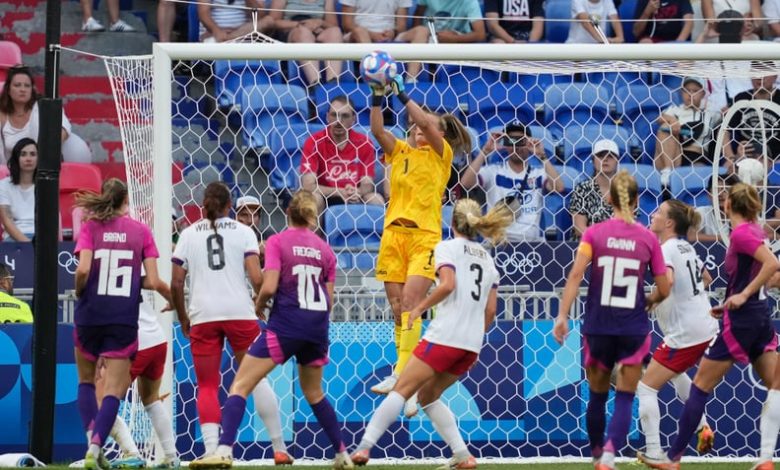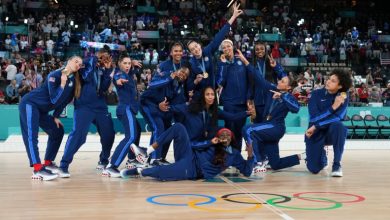Why Do Soccer Goalies Wear a Different Color Uniform?

When you watch a soccer game, the easiest players to pick out are almost always the goalkeepers, aka goalies. Not only do they stay mostly in one place throughout a match, but they’re always wearing jerseys of a totally different color than the players in other positions. Sometimes, their jerseys aren’t even a color that’s in their team’s palette at all! For example, at the 2023 FIFA Women’s World Cup, you might see the USWNT goalies wearing bright green or orange, while the rest of the team is in red, white, and blue.
It’s not just a style choice — it’s actually a core rule of soccer. Here’s why soccer goalies wear a different color, plus a few other things you might not know about goalkeepers.
Why Do Goalies Wear a Different Color Uniform?
It’s actually part of the official rules of the game. Goalies need to wear jerseys that are a different color than the rest of the players, according to the International Football Association Board. Specifically, the rules state, “Each goalkeeper must wear colours that are distinguishable from the other players and the match officials. If the two goalkeepers’ shirts are the same colour and neither has another shirt, the referee allows the match to be played.”
In other words, each goalie should be the only person on the field wearing their specific colored shirt. It might be an “accent” color from their team’s existing uniform palette, or it could be a color that the individual goalie prefers for whatever reason. There’s no formal “reason” listed in the rules, but presumably, it’s to ensure that the goalies, who have slightly different jobs (and rules) than other players, are easy for game officials to spot easily and officiate correctly, even in the chaos of gameplay. Intriguingly, there’s even some research that suggests that wearing specific colors can have an impact on opposing players: a study found that players scored fewer penalty kicks against goalkeepers wearing red!
If both goalies accidentally wear the same color jerseys, one or both of them is technically supposed to change. If they aren’t able to, though, the referee can let them ago ahead with the game. After all, goalies typically stay in their respective goal areas on opposite sides of the field, so the likelihood of them getting mixed up with each other is pretty minimal.
The rules of the game also allow a few other special guidelines for what goalies can wear. Unlike other players, goalies are permitted to wear “tracksuit bottoms” in place of shorts. There’s no reason for this given in the rules, but most goalies prefer pants because it protects their skin from the impact of sliding and diving on scratchy grass or turf to make saves. They’re also allowed to wear “goalkeepers’ caps,” which are essentially baseball caps that can provide protection from heat, sun, sweat, and glare while on the field. Other players can wear head coverings, but only in styles that are “non-protruding” (i.e. definitely not a brimmed cap).
What Other Rules Do Goalies Have?
Goalies get to do more than just wear different uniforms than the rest of the players. They also have a few special rules that apply only to them during the game. The biggest one is that they’re the only players on the field who are allowed to use their hands. Goalies use their hands as a core part of their position, in fact, since their job is to stop the ball from entering the net. Any other player on the field, however, is forbidden from using their hands or arms. That’s why you’ll see moves like “heading” the ball, to move the ball along when kicking it isn’t a good choice. Even goalies are subject to this rule sometimes: if they move outside their own penalty area (a large rectangular section at the end of the field marked by a white line), they stop being able to use their hands and arms.
Being a goalie is a very demanding role, and their differently colored jerseys put them in even more of a spotlight. Next time you tune into a soccer match, keep an eye out for their incredible athletics — they’ll be easy to see!
— Additional reporting by Jade Esmeralda
Amanda Prahl is a freelance writer, playwright/lyricist, dramaturg, teacher, and copywriter/editor. Amanda has also contributed to Slate, Bustle, Mic, The Mary Sue, and others.
Jade Esmeralda, MS, CSCS, is a health and fitness staff writer. A lifelong martial artist and dancer, Jade has a strong passion for strength and conditioning, sports science, and human performance. She graduated with a Master of Science degree in exercise science and strength and conditioning from George Washington University.




